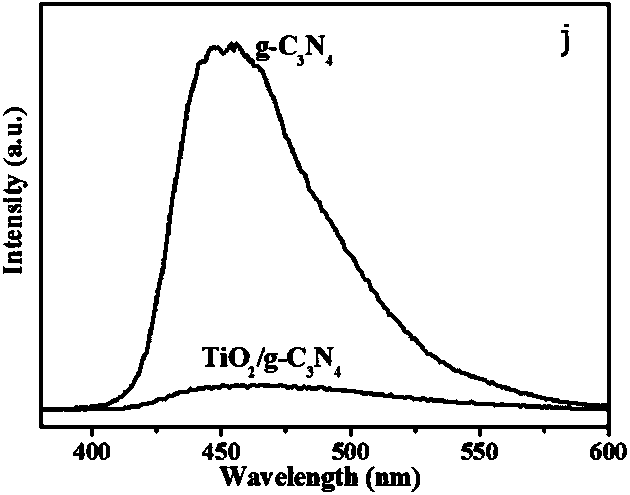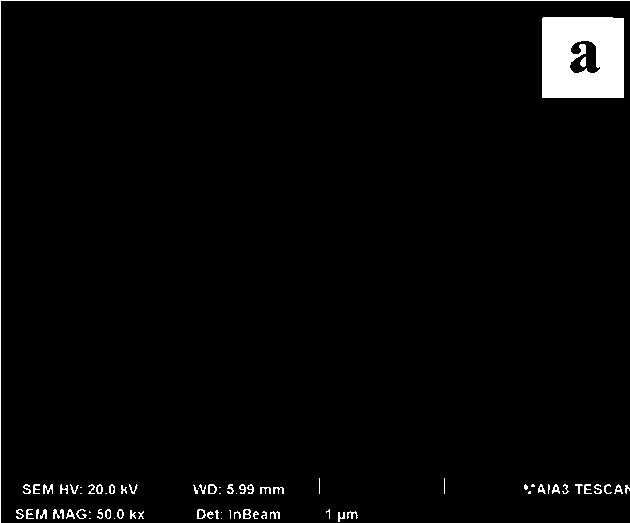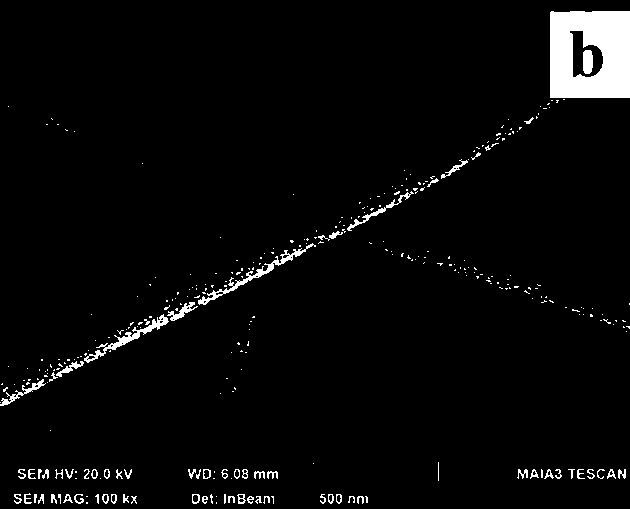A fibrous z-shaped photocatalyst tio for treating organic sewage 2 /g-c 3 no 4 preparation method
A photocatalyst and organic sewage technology, applied in the direction of physical/chemical process catalysts, chemical instruments and methods, energy wastewater treatment, etc., can solve the problems of potential safety hazards, easy agglomeration of composite materials, and no reports, etc., to broaden the space for photogenerated electrons Hole space distance, easy separation and recycling, and the effect of improving utilization efficiency
- Summary
- Abstract
- Description
- Claims
- Application Information
AI Technical Summary
Problems solved by technology
Method used
Image
Examples
Embodiment 1
[0032]Add 9ml of methanol, 0.3ml of glacial acetic acid, 2ml of tetrabutyl titanate and 0.56g of polyvinylpyrrolidone to the Erlenmeyer flask in turn, stir for 3 hours to obtain a uniform spinning solution, and put the spinning solution into a plastic syringe with a stainless steel needle Carry out high-voltage electrospinning, the spinning voltage is 12kV, the receiving distance is 15cm, and the air humidity is 39%, to obtain tetrabutyl titanate / polyvinylpyrrolidone fiber membrane, put the composite fiber membrane into a temperature-programmed muffle furnace, and heat up The speed is set at 2°C / min, and calcined at 500°C for 2h to obtain porous TiO 2 Nanofibers.
[0033] Weigh the above porous TiO 2 Add 360 mg of nanofibers to 50 ml of distilled water, and ultrasonically grind the porous TiO 2 The nanofibers were crushed into short fibers and dispersed evenly in water, then 3 g of melamine was added, stirred by magnetic force and heated to 98 ° C, and the distilled water wa...
Embodiment 2
[0035] Add 8ml of methanol, 0.4ml of glacial acetic acid, 2ml of tetrabutyl titanate and 0.7g of polyvinylpyrrolidone to the Erlenmeyer flask in turn, and stir for 3.5h to obtain a uniform spinning solution. The syringe was subjected to high-voltage electrospinning, the spinning voltage was 12kV, the receiving distance was 15cm, and the air humidity was 35% to obtain a tetrabutyl titanate / polyvinylpyrrolidone fiber membrane, and the composite fiber membrane was placed in a temperature-programmed muffle furnace, The heating rate is set at 2°C / min, and calcined at 500°C for 2 hours to obtain porous TiO 2 Nanofibers.
[0036] Weigh the above porous TiO 2 Add 90 mg of nanofibers to 45 ml of distilled water, and ultrasonically grind the porous TiO 2 The nanofibers were crushed into short fibers and dispersed evenly in water, then 3.0 g of melamine was added, stirred by magnetic force and heated to 98 ° C, and the distilled water was evaporated to dryness, and the melamine in the ...
Embodiment 3
[0038] Add 7ml of methanol, 0.4ml of glacial acetic acid, 2.5ml of tetrabutyl titanate and 0.8g of polyvinylpyrrolidone to the Erlenmeyer flask in sequence, and stir for 3.5h to obtain a uniform spinning solution. High-voltage electrospinning was carried out with a plastic syringe, the spinning voltage was 14kV, the receiving distance was 14cm, and the air humidity was 35% to obtain tetrabutyl titanate / polyvinylpyrrolidone fiber membrane, and the composite fiber membrane was placed in a temperature-programmed muffle furnace , the heating rate was set at 2.5°C / min, and calcined at 500°C for 1.5h to obtain porous TiO 2 Nanofibers.
[0039] Weigh the above porous TiO 2 Add 180 mg of nanofibers to 45 ml of distilled water, and ultrasonically grind the porous TiO 2 The nanofibers were crushed into short fibers and dispersed evenly in water, then 4 g of melamine was added, magnetically stirred and heated to 99 ° C, and the distilled water was evaporated to dryness, and the melamin...
PUM
| Property | Measurement | Unit |
|---|---|---|
| specific surface area | aaaaa | aaaaa |
| specific surface area | aaaaa | aaaaa |
Abstract
Description
Claims
Application Information
 Login to View More
Login to View More - R&D
- Intellectual Property
- Life Sciences
- Materials
- Tech Scout
- Unparalleled Data Quality
- Higher Quality Content
- 60% Fewer Hallucinations
Browse by: Latest US Patents, China's latest patents, Technical Efficacy Thesaurus, Application Domain, Technology Topic, Popular Technical Reports.
© 2025 PatSnap. All rights reserved.Legal|Privacy policy|Modern Slavery Act Transparency Statement|Sitemap|About US| Contact US: help@patsnap.com



